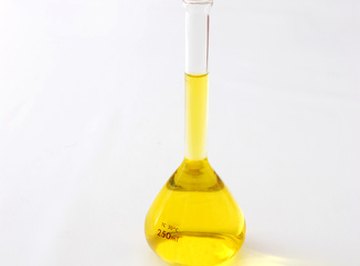
High-performance liquid chromatography (HPLC) is a laboratory technique used to separate and identify compounds. It is a type of column chromatography that relies on different polarities of compounds in a solution in order to separate them. HPLC differs from standard column chromatography because it uses pressure to force the solution through the column more quickly, and therefore produces quicker, and sometimes more accurate, results. The goal is to separate compounds in the column and have them exit separately.
Coelution
Because of the speed of HPLC and it reliance on different polarities of compounds, two compounds with similar structure and polarities can exit the chromatography apparatus at the same time or nearly the same time. This is known as coelution. Coelution makes determining exactly which portion of the mixture eluted at what point difficult.
Adsorbed Compounds
HPLC typically uses a glass column filled with beads made of different materials. The mixtures being forced through the column have chemicals that bind with different strengths to the beads. The strength of the binding, which depends on the similarity in polarity, determines how long the chemical will bind to the bead before being released. Some compounds bind so strongly that they are essentially never released from the beads in the column and are never measured in the solution exiting the column.
Cost
Typical laboratory separation techniques involve developing an assay, or method of separation, and then implementing that assay to separate individual compounds from a solution. However this usually results in multiple solutions that also need to undergo procedures, leading to an exponential increase in complexity. Although HPLC can often simplify and speed up this process, the cost of developing an HPLC apparatus can become tremendous. Developing an HPLC apparatus, although much more efficient, is much more costly than developing other assays for separating compounds. This makes it not financially viable for many small privately owned laboratories.
Complexity
HPLC is not only used to separate simple compounds, it is also used to isolate specific proteins out of a cellular mixture. In this case the beads in the column are usually coated with an antibody specific to the protein you need to collect. The proteins bind the the antibodies and the remaining solution is passed through the column, then the proteins are released using another solution and collected. This requires a highly skilled technician to monitor the column at all times and make sure that the process is running exactly as planned.
References
- Colorado University: Chem 5181: Mass Spectrometry & Chromatography; Dr. Daniel J. Cziczo
- "HPLC, A Practical User's Guide; Marvin C. McMaster; 2007
About the Author
Rebecca Burdick began her freelance writing career in 2007 and currently writes for several online publications. She specializes in small business bookkeeping and financial management. Burdick studied accounting and economics at Boise State University and University of California at Riverside.
Photo Credits
flask image by Hubert from Fotolia.com
